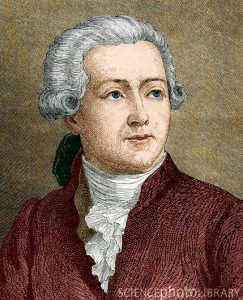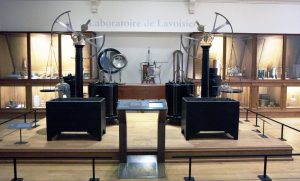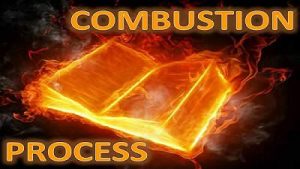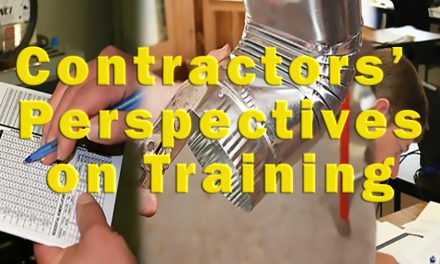The fuel is burning, the flame is hot and blue, so it must be okay! This is hardly 21st century combustion diagnostics but rather 17th century theory.

Antoine Laurent Lavoisier: 1743-1794.Many consider him the Father of Modern Chemistry and Combustion
It was in the early 17th century that Flemish alchemist, Johannes Baptista van Helmont decided to study combustion. He visually determined that combustion was the release of ‘wild spirits’ as a flame burned. He believed the fumes, smoke, and ash were stored in the burning material and escaped as it was heated. This was later defined by German alchemist Johann Belcher as the ‘phlogiston (flo-gis-ton) theory’ and is what many still believe when they say there was a carbon monoxide leak.
It wasn’t until the late 17th century that the combustion process was identified by French chemist, Antoine Laurent Lavoisier. He explained that combustion was oxidation and was criticized for being a radical because oxygen was only discovered in 1771. However, because he performed many tests to prove his findings, he was finally accepted as being correct. It shouldn’t seem strange to you that testing was not very popular back then and everything was based on theory and consensus. Sometimes I wonder if we have advanced any farther today?
Suppose when you went to the doctor for an illness, all he checked was your blood pressure, temperature, and weight. He might ask what you’ve been eating and say your color looks good, therefore you are okay! When all you do is check gas pressure, measure delta t, clock the meter, and look for a blue flame, you have accomplished about the same thing. In reality, none of these have anything to do with safe, mechanically sound, and efficient combustion. Does ‘That’s the way it’s always been done’ justify continuing to do so?
Most companies invest thousands of dollars in tools and training to install and service air conditioning systems. They even get EPA certified! I do not recall many incidents where an air conditioning system poisoned or killed someone. The media has confused carbon monoxide poisonings from defective air conditioning systems in the past, but that was bad reporting. Beyond safety, testing and training is about making systems operate correctly!

A replica of Lavoisier’s laboratory exists in the Musee du Paris
It is unfortunate much of the industry believes the tests above validate proper equipment operation. It is hard to believe something so simple still has so many confused and insecure. Besides generating greater income and profits, understanding the real combustion process and how to diagnose it, might just save someone’s life, including your own.
The combustion process is relatively simple. It is a matter of combining fuel and air and igniting it with a heat source. This assumes everything is mechanically sound after it is installed on the job and tested. Nothing can be pre-set at the factory to address all field applications.
Fuel and air both need to be controlled in all cases and possibly adjusted to maximize equipment safety and efficiency. This should appear to be a logical approach to the combustion process; however, according to many industry standards, this is not the case. Fuel is controlled but rarely allowed to be adjusted and air is ignored all together!
Why Are We Ignoring Air?
If you don’t control air, don’t adjust the fuel! To do so would be reckless and dangerous. This brings up the question, why are we ignoring air?
According to code, providing openings in a wall or ceiling will deliver necessary combustion air. However, an ASHRAE study in 2000 concluded that code-approved combustion air does not provide adequate combustion air. There are too many forces in a building competing for that air, whether it is building leakage, duct leakage, or other exhausting appliances.
A force is needed to draw air into the burner. This force is draft. Most think of draft as the force that removes flue gases from equipment. True enough. But it also draws in combustion air.
How is draft produced? In normal flues, draft is created by communicating the inside flue temperature and mechanical room pressure to outside temperature and barometric pressure. The flue is the device that connects them to each other. The exception would be draft that is created by inducers on most newer condensing equipment. Outside temperature and pressure constantly vary and affect draft. Therefore, draft is a variable that needs to be controlled or there is no control of combustion air and venting.
For draft to control combustion air and venting, the flue must be connected to the appliance, not just in the vicinity. Unfortunately, not every piece of drafthood equipment is connected to a flue.
 Currently, controlling residential or commercial combustion air and venting is still not an industry recommendation. Therefore, it’s easy to understand why no one wants us to adjust fuel since there is no guarantee of air to mix with it.
Currently, controlling residential or commercial combustion air and venting is still not an industry recommendation. Therefore, it’s easy to understand why no one wants us to adjust fuel since there is no guarantee of air to mix with it.
A common assumption made is if you have draft, you have proper combustion air and venting. Or if your air proving pressure switches are made, you are proving proper combustion air and venting. This is incorrect! Only proper combustion testing and diagnostics can guarantee adequate combustion air and correct venting. Does this seem like something the HVAC industry should address or just continue to ignore?
Look at the equipment you service and see how many have rust on the burners, heat exchanger, or flue. If you see the rust, that equipment has venting problems and possibly combustion air problems. Remember, fuel is regulated 100% of the time so it makes sense to regulate air. This would require us to control draft which is constantly changing.
There are millions of accidents just waiting to happen if they are not already happening. The places they will occur are pre-existing. There are the select few who choose to step forward into the 21st century of combustion diagnostics, while the rest are satisfied with the 17th century theories.













Recent Comments